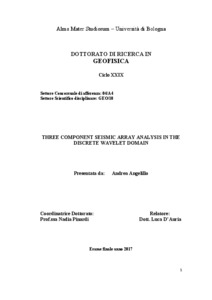Angelillo, Andrea
(2017)
Three-Component Seismic Array Analysis in the Discrete Wavelet Domain, [Dissertation thesis], Alma Mater Studiorum Università di Bologna.
Dottorato di ricerca in
Geofisica, 29 Ciclo. DOI 10.6092/unibo/amsdottorato/8053.
Documenti full-text disponibili:
![[img]](http://amsdottorato.unibo.it/8053/1.hassmallThumbnailVersion/Angelillo_Andrea_tesi.pdf)  Anteprima |
|
Documento PDF (English)
- Richiede un lettore di PDF come Xpdf o Adobe Acrobat Reader
Disponibile con Licenza: Salvo eventuali più ampie autorizzazioni dell'autore, la tesi può essere liberamente consultata e può essere effettuato il salvataggio e la stampa di una copia per fini strettamente personali di studio, di ricerca e di insegnamento, con espresso divieto di qualunque utilizzo direttamente o indirettamente commerciale. Ogni altro diritto sul materiale è riservato.
Download (7MB)
| Anteprima
|
Abstract
The purpose of this PhD thesis was the development of an innovative methodology for the seismic array data analysis, named DWT-MuSiC (Discrete Wavelet Transform -Multiple Signals Classification).
DWT-MuSiC is a new proposed method intended to be able to perform near-real time analysis relating to the detection of different seismic wave field and their characterization, starting from raw seismic array data.
The innovative point of DWT-MuSiC is that it is thought to combine the resolution of the MuSiC (Multiple Signals Classification) algorithm, methodology used for frequency estimation and source location, proposed by Schmidt (1986), and the potentialities of the discrete wavelet domain analysis. The DWT-MuSiC, in fact other than detecting the presence of different wavefronts, provides both their direction of arrival and apparent speed of advancement, returning even information about the polarization of each identified phases, preserving furthermore spatial and frequency information of the original signals.
The synthetic tests performed with the DWT-MuSiC analysis have shown the ability of the algorithm to detect wake signals also in presence of a low signal to noise ratio. The method returned correct output also in those cases where the analysis is performed on multiple seismic phases that overlap in terms of impinging time or/and frequency content of the signals themselves. The comparison between other methodology like the beamforming and MuSiC applied in the Fourier domain, shown how the information returned by the DWT-MuSiC was much more complete. The use of discrete wavelets and the optimization algorithm implemented in the analysis permit moreover to save computational time analyzing only the important data, allowing the recovery of hidden information when more than one wavefronts overlap.
The application to real case on data collected at Mount Vesuvius (Italy) and at Krafka caldera (Island) were important to test the applicability of the methodology in different contests.
Abstract
The purpose of this PhD thesis was the development of an innovative methodology for the seismic array data analysis, named DWT-MuSiC (Discrete Wavelet Transform -Multiple Signals Classification).
DWT-MuSiC is a new proposed method intended to be able to perform near-real time analysis relating to the detection of different seismic wave field and their characterization, starting from raw seismic array data.
The innovative point of DWT-MuSiC is that it is thought to combine the resolution of the MuSiC (Multiple Signals Classification) algorithm, methodology used for frequency estimation and source location, proposed by Schmidt (1986), and the potentialities of the discrete wavelet domain analysis. The DWT-MuSiC, in fact other than detecting the presence of different wavefronts, provides both their direction of arrival and apparent speed of advancement, returning even information about the polarization of each identified phases, preserving furthermore spatial and frequency information of the original signals.
The synthetic tests performed with the DWT-MuSiC analysis have shown the ability of the algorithm to detect wake signals also in presence of a low signal to noise ratio. The method returned correct output also in those cases where the analysis is performed on multiple seismic phases that overlap in terms of impinging time or/and frequency content of the signals themselves. The comparison between other methodology like the beamforming and MuSiC applied in the Fourier domain, shown how the information returned by the DWT-MuSiC was much more complete. The use of discrete wavelets and the optimization algorithm implemented in the analysis permit moreover to save computational time analyzing only the important data, allowing the recovery of hidden information when more than one wavefronts overlap.
The application to real case on data collected at Mount Vesuvius (Italy) and at Krafka caldera (Island) were important to test the applicability of the methodology in different contests.
Tipologia del documento
Tesi di dottorato
Autore
Angelillo, Andrea
Supervisore
Dottorato di ricerca
Ciclo
29
Coordinatore
Settore disciplinare
Settore concorsuale
Parole chiave
Music array wavelet discrete wavelet transform DWT Krafla Vesuvius backazimuth DOA slowness polarization
URN:NBN
DOI
10.6092/unibo/amsdottorato/8053
Data di discussione
22 Maggio 2017
URI
Altri metadati
Tipologia del documento
Tesi di dottorato
Autore
Angelillo, Andrea
Supervisore
Dottorato di ricerca
Ciclo
29
Coordinatore
Settore disciplinare
Settore concorsuale
Parole chiave
Music array wavelet discrete wavelet transform DWT Krafla Vesuvius backazimuth DOA slowness polarization
URN:NBN
DOI
10.6092/unibo/amsdottorato/8053
Data di discussione
22 Maggio 2017
URI
Statistica sui download
Gestione del documento:


 Login
Login
